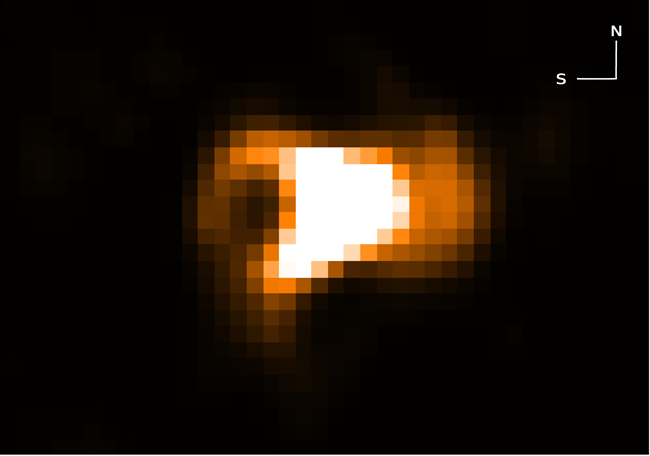The Great Expanding Space Peanut!

A thermonuclear explosion on a dead star has resulted inan expanding space bubble shaped like a peanut.
The unusualsight arose from an unstable pairing of two aged stars: a white dwarf and ared giant in the constellation of Ophiuchus, known collectively as RS Oph.Astronomers imaged the double-lobed peanut structure's material expandingoutwards at between 621 and 1,864 miles per second (1,000 and 3,000 kps).
"There are some astronomers who believe systems likethis will ultimately explodeas supernovae," said Valerio Ribeiro, an astrophysics researcher atLiverpool John Moores University in the UK.
The white dwarf represents an Earth-sized dead star thatpulls hydrogen-rich gas from the red giant's outer layers. Every 20 years or so,that buildup of gas eventually causes a cataclysmic explosion similar to thatcreated by a hydrogen bomb's uncontrolled fusionreaction.
Energy output from RS Oph reaches 100,000 times that ofthe sun during such events, and the eruption ejects an amount of materialequivalent to Earth's mass at hundreds of miles per second.
The red giant is a bloated, late-stage star whose daysare numbered. Researchers point to the redgiant's wind as the culprit behind the unusual shaping of the expandingnebula. That wind usually forces surrounding material to gather near the stars'orbital plane and leaves less near the poles.
When an outburst occurs, high-speed material from theeruption hits the dense gas in the orbital plane and slows down, but itcontinues moving outward at high speed in the polar areas to form thedouble-lobed peanut shape.
Breaking space news, the latest updates on rocket launches, skywatching events and more!
Japanese amateur astronomers first spotted the system's latestbrightening on Feb. 12, 2006, which prompted scientists to turn to morepowerful ground-based radio telescopes and NASA's Hubble Space Telescope.
The research was to be presented April 22 at the EuropeanWeek of Astronomy and Space Science conference at the University ofHertfordshire.
- Video: Eta Carinae and Hypernovas
- Video - Supernova: Destroyer + Rebuilder
- Top 10 Star Mysteries

Space.com is the premier source of space exploration, innovation and astronomy news, chronicling (and celebrating) humanity's ongoing expansion across the final frontier. Originally founded in 1999, Space.com is, and always has been, the passion of writers and editors who are space fans and also trained journalists. Our current news team consists of Editor-in-Chief Tariq Malik; Editor Hanneke Weitering, Senior Space Writer Mike Wall; Senior Writer Meghan Bartels; Senior Writer Chelsea Gohd, Senior Writer Tereza Pultarova and Staff Writer Alexander Cox, focusing on e-commerce. Senior Producer Steve Spaleta oversees our space videos, with Diana Whitcroft as our Social Media Editor.
